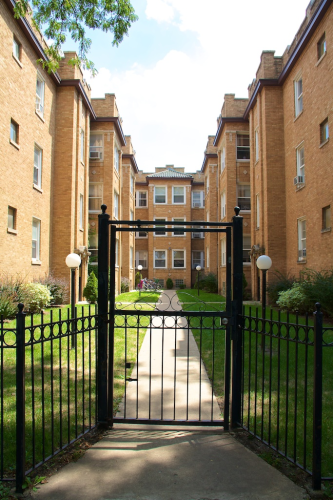Mar 13, 2013
Chicago neighborhoods hardest hit by foreclosure crisis show signs of stabilizing
Chicago neighborhoods hardest hit by foreclosure crisis show signs of stabilizing
CHICAGO — Home prices in Chicago’s Englewood/Auburn Gresham neighborhoods that were among the hardest hit by the foreclosure crisis are showing signs of stabilizing, according to a fourth quarter Cook County House Price Index released by DePaul University’s Institute for Housing Studies.
Since bottoming out in the first quarter of 2011, home prices in the Englewood/Auburn Gresham neighborhoods have been steadily increasing. In the fourth quarter of 2012, values were up 10 percent from recent lows, but still down 15 percent from what they were in 2000.
The institute’s fourth quarter 2012 House Price Index highlights price changes for single-family homes and condominiums in 19 Chicago submarkets and 14 suburban Cook County submarkets.
Other areas severely affected by the housing crisis that have shown recent signs of stability include the Humboldt Park/Garfield Park and Pullman/Roseland neighborhoods of Chicago. Humboldt Park/Garfield Park saw price increases of nearly 4 percent and quarter-over-quarter price increases of nearly 3 percent, after experiencing price declines of more than 40 percent since 2000 and reaching a low point in the first quarter of 2012.
The Pullman/Roseland neighborhoods experienced a year-over-year price increase of nearly 19 percent — the largest of all submarkets studied — in the fourth quarter of 2012. The neighborhoods had previously experienced price declines of nearly 8 percent since 2000, reaching a low point in the first quarter of 2012.
“Recent price increases in these foreclosure-distressed markets are an indication that prices in these areas may have bottomed out,” said institute executive director Geoff Smith. “However, it will be important to track how sustained these price increases are to know if they are a temporary phenomenon or if these areas have truly stabilized.”
Meanwhile, price trends in neighborhoods in the central part of Chicago and along Lake Michigan are emerging as the county’s strongest. These areas exhibit strong long-term price increases as well as recent signs of price stability. Home prices in the Loop have increased by 36 percent since 2000, the largest gain of any Cook County submarket, and increased nearly 5 percent year over year in the fourth quarter of 2012. Prices in the Lakeview/Lincoln Park, West Town/Logan Square, and Bronzeville/Hyde Park neighborhoods of Chicago have also shown both positive long-term growth as well as recent price gains.
While these Chicago submarkets have seen recent price improvements, the vast majority of Cook County’s local housing markets remain fairly weak. As of the fourth quarter 2012, 24 of the county’s 33 submarkets were at or near their lowest price levels since the collapse of the housing market in 2007.
“The housing market is seeing positive signs in the strongest markets and in areas where prices have bottomed out,” Smith said. “However, the rest of the county continues to struggle.”
The institute’s Cook County House Price Index, in addition to tracking quarterly price changes for single family homes and condominium units, also tracks small rental buildings with two to four units and larger rental buildings with five or more units. Other key findings show:
● The condominium market, both in suburban Cook County and Chicago, remained the weakest market segment. In the fourth quarter of 2012, condominium prices were down nearly 10 percent year over year and down more than 2 percent quarter over quarter.
● Prices for single-family homes were essentially unchanged year over year in the fourth quarter of 2012. Single-family home prices in Cook County remained fairly flat with limited quarter-over-quarter changes throughout the year.
● The rental market remained a positive part of the Cook County’s housing markets, but price growth has slowed. Between the fourth quarter of 2011 and the fourth quarter of 2012, prices for small rental buildings increased by roughly 2 percent, but these price increases were largely due to price growth in the high-value segment of the small rental property market. High-value small rental properties saw year-over-year price growth of nearly 12 percent and have experienced three consecutive quarters of price increases.
● Larger multifamily rental buildings continue to benefit from strong rental demand and the limited supply of new rental housing, but after experiencing strong price growth throughout 2011 and the first half of 2012, large multifamily rental properties saw price declines in the third and fourth quarters of 2012. Despite these recent declines, prices for large multifamily rental properties ended 2012 just 2 percent higher than they were at the end of 2011.
Visit housingstudies.org for the most recent summary of quarterly IHS Cook County House Price Index data. Archived quarterly summaries are also available online.
About the Institute for Housing Studies
The Institute for Housing Studies is a research center based at DePaul University that provides analysis and data to inform affordable housing policy and practice. More about IHS and its research can be found at housingstudies.org.
The institute’s House Price Index tracks quarterly price changes for the four primary residential property types found in the County: single family homes, condominium units, small rental buildings with two to four units, and larger rental buildings with five or more units. The index also breaks out Cook County house price changes for single-family homes and condominiums in 19 submarkets located in the city of Chicago and 14 submarkets in suburban Cook County.
###
SOURCE:
Geoff Smith
312-362-5962

